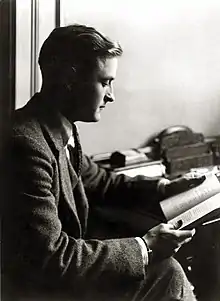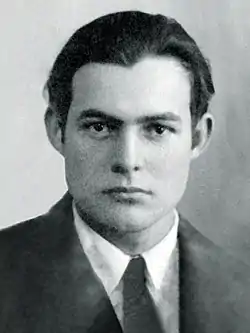Save Me the Waltz
Save Me the Waltz is a 1932 novel written by American author Zelda Sayre Fitzgerald. It is a semi-autobiographical account of her life and marriage to F. Scott Fitzgerald.
.gif) First edition cover of Save Me the Waltz | |
| Author | Zelda Fitzgerald |
|---|---|
| Cover artist | Cleonikes Damianakes |
| Country | United States |
| Language | English |
| Genre | Tragedy |
| Published | October 7, 1932 |
| Publisher | Charles Scribner's Sons |
| Media type | Print (hardcover & paperback) |
Background
By the 1930s, Zelda Fitzgerald had already been in and out of psychiatric facilities, and her husband was stalled writing his next work; he had not produced a novel since 1925's The Great Gatsby. After an episode of hysteria, Zelda was admitted to the Phipps Clinic at Johns Hopkins Hospital in Baltimore on February 12, 1932 for treatment by Dr. Adolf Meyer, an expert on schizophrenia.[1] As part of her recovery routine, she spent at least two hours a day writing.[2]
Zelda developed a bond with a young female resident, Dr. Mildred Squires, and toward the end of February she shared an aspect of her novel with Squires, who wrote to Scott that the novel was vivid and had charm.[3][4] Meanwhile, Scott became worried that Zelda's treatment would consume all his money, so he set aside his novel to work on short stories to fund the treatment. Zelda wrote to Scott from the hospital, "I am proud of my novel, but I can hardly restrain myself enough to get it written. You will like it—It is distinctly École Fitzgerald, though more ecstatic than yours—perhaps too much so."[5][6] Zelda wrote furiously each day; she finished the novel on March 9 and sent the unaltered manuscript to Scott's publisher, their friend Maxwell Perkins at Scribner's. Perkins thought the manuscript was unimpressive, but he agreed to publish the book regardless.[7]
Scott was "hurt" that Zelda had not shown her manuscript to him before sending a copy to Perkins.[8] He also was shocked that Zelda's novel covered the same events which he had been working on for four years in his unfinished novel.[9] (Scott would use much of the same autobiographical material in his 1934 novel Tender Is the Night.) Zelda wrote him, "I was also afraid we might have touched the same material."[10] Scott was also angry that she had named her heroine's husband Amory Blaine, the name of the young protagonist of Scott's first novel This Side of Paradise.[11] However, despite his annoyance, "the revisions [which] Scott finally demanded were actually relatively few, and that the disagreement was quickly resolved, with Scott recommending the novel to Perkins."[12] Scott wrote to Perkins: "Here is Zelda's novel. It is a good novel now, perhaps a very good novel—I am too close to tell. It has the faults and virtues of a first novel. ... It is about something and absolutely new, and should sell."[13][14]
Zelda signed the contract to publish the book on June 14, 1932. It was published on October 7 with a printing of 3,010 copies—not unusually low for a first novel in the middle of the Great Depression[15]—on cheap paper, with a cover of green linen.[16]
According to Zelda, the book derived its title from a Victor record catalog,[17] and it suggests the romantic glitter of the life which F. Scott Fitzgerald and herself lived and which Scott's novels have so indelibly written into American literary and cultural history. Divided into four chapters, each of which is further divided into three parts, the novel is a chronological narrative of four periods in the lives of Alabama and David Knight, names that are but thin disguises for their real-life counterparts.
Plot
Alabama Beggs, a girl who "wanted her own way about things",[18] marries a twenty-two-year-old artist, David Knight. As with Zelda and Scott, Alabama met David when he was an Army officer stationed in her Southern town during World War I. Knight becomes a successful painter, and the family moves to the Riviera where Alabama has a romance with a French aviator. Later David abandons her at a nightmarish dinner party to spend the night with a fashionable dancer. Determined to be successful in her own right, Alabama decides to become a ballerina and devotes herself relentlessly to the cause. She grows further and further apart from her husband and daughter. She is offered an opportunity to dance featured parts with a prestigious company in Naples—and she takes it, and goes to live in the city alone; in life Zelda was offered a similar chance but did not take it.
Alabama dances her solo debut in the opera Faust. A blister becomes infected from the glue in the box of her toe shoe, leading to blood poisoning, and Alabama can never dance again. Though outwardly successful, Alabama and David are miserable. At the novel's end they return to the South where Alabama's father is dying. Though she says otherwise, her friends from the South go on about how happy and lucky Alabama is. Alabama searches for meaning in her father's death, but finds none. While cleaning up after their final party before returning to their unhappy lives, Alabama remarks that emptying the ashtrays is "very expressive of myself. I just lump everything in a great heap which I have labeled 'the past,' and having thus emptied this deep reservoir that was once myself, I am ready to continue."
The last paragraph shows the Knights immobile:
"They sat in the pleasant gloom of late afternoon, staring at each other through the remains of the party; the silver glasses, the silver tray, the traces of many perfumes; they sat together watching the twilight flow through the calm living-room that they were leaving like the clear cold current of a trout stream."
Reception
The reviews by literary critics were mostly negative. The critics deemed the prose overwritten, the characters weak and uninteresting, and scenes which should have been tragedy instead a "harlequinade". The New York Times wrote: "It is not only that her publishers have not seen fit to curb an almost ludicrous lushness of writing but they have not given the book the elementary services of a literate proofreader."[19] Zelda was greatly depressed by the negative reviews, though she acknowledged to Maxwell Perkins that a review from William McFee, writing in The New York Sun, was at least intelligible. McFee wrote:
"In this book, with all its crudity of conception, its ruthless purloinings of technical tricks and its pathetic striving after philosophic profundity, there is the promise of a new and vigorous personality in fiction."[19]
Malcolm Cowley, a friend of the Fitzgeralds, read the book and wrote to Scott, "It moves me a lot: she has something there that nobody got into words before."[19] Yet another friend, Ernest Hemingway, believed the work lacked artistic merit and warned editor Maxwell Perkins that if he ever published a novel by any of his wives, "I'll bloody well shoot you."[20] Perkins himself was unimpressed by the work.[21]
The book sold only 1,392 copies for which she earned $120.73.[15] The failure of Save Me the Waltz crushed Zelda's spirits. She had been working throughout the fall of 1932 on a second novel, based on her experiences in psychiatric treatment. But Scott's reaction was unkind. In a fight before Zelda was readmitted to treatment, Fitzgerald said her novel was "plagiaristic, unwise in every way... should not have been written."[22] Zelda asked, "Didn't you want me to be a writer?" Though Scott once had, he lashed out, "No, I do not care whether you were a writer or not, if you were any good... [but] you are a third-rate writer and a third-rate ballet dancer."[22] The psychiatrist agreed with Scott. Zelda was devastated; she never published another novel.
Footnotes
- Cline 2003, p. 304
- Milford 1970, pp. 209–12
- Fitzgerald & Fitzgerald 2009, p. 145
- Milford 1970, p. 213
- Fitzgerald & Fitzgerald 2009, p. 156
- Milford 1970, p. 215
- Berg 2013, p. xi
- Fitzgerald & Fitzgerald 2009, p. 163
- Milford 1970, p. 220
- Fitzgerald & Fitzgerald 2009, p. 163
- Berg 2013, p. xi
- Fitzgerald & Fitzgerald 2009, p. 164
- Cline 2003, pp. 306–307
- Milford 1970, p. 225
- Milford 1970, p. 264
- Cline 2003, p. 320
- Fitzgerald & Fitzgerald 2009, p. 207
- Fitzgerald 2013, p. 220
- Milford 1970, p. 263
- Berg 2013, p. xi
- Berg 2013, p. xi
- Cline 2003, p. 325
References
- Berg, A. Scott (2013). Max Perkins: Editor of Genius. New York: Simon and Schuster. ISBN 978-1-4711-3010-6.
- Fitzgerald, F. Scott; Fitzgerald, Zelda (2009) [1985]. Bryer, Jackson R.; Barks, Cathy W. (eds.). Dear Scott, Dearest Zelda: The Love Letters of F. Scott and Zelda Fitzgerald. Scribner. ISBN 978-1-9821-1713-9.
- Cline, Sally (2003). Zelda Fitzgerald: Her Voice in Paradise. New York: Arcade Publishing. ISBN 1-55970-688-0.
- Fitzgerald, Zelda (2013). Save Me the Waltz. New York: Simon and Schuster. ISBN 978-1-4767-5893-0.
- Milford, Nancy (1970). Zelda: A Biography. New York: Harper & Row. ISBN 978-0-0601-2991-0.
- "Book Notes". The New York Times. New York. p. 23. May 26, 1932.



